



10Ο◆
Michelangelo Pistoletto
Ragazza in minigonna / Ragazza seduta per terra
painted tissue paper with graphite and coloured pencil on polished stainless steel
230.2 x 120 x 2.2 cm (90 5/8 x 47 1/4 x 0 7/8 in.)
Executed in 1962-1967.